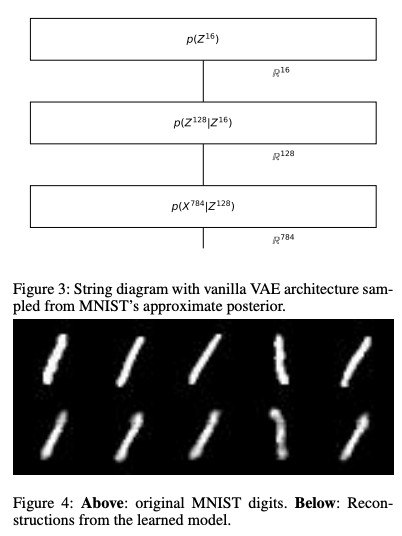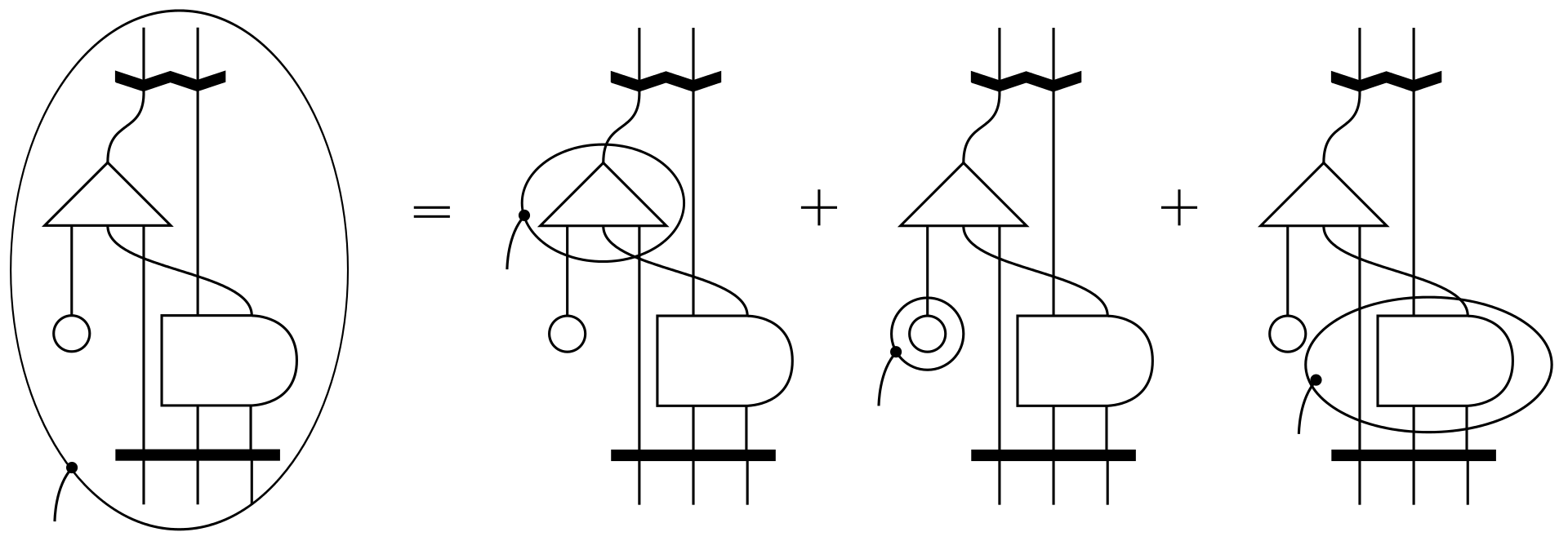Boxes and signatures
A box represents any process with systems as input and output.

A (monoidal) signature
- a pair of classes
- a pair of maps
Boxes and signatures
Given two signatures
a morphism
where
Diagrams: definition
Given a signature
- every box
- the identity
- so is the composition
- and the tensor
Diagrams: definition
Diagrams are subject to three axioms.
- Tensor and composition are associative and unital.
- The interchanger
which is equivalent to the following spacelike separation axiom:

Diagrams: quantum circuits
Quantum gate sets are signatures!

- Wires are bits and qubits.
- Boxes are quantum gates
and measurements. - Diagrams are circuits.
Diagrams: grammatical structures

Formal grammars are signatures!
Chomsky: Syntactic Structures (1957)
- Wires are grammatical types.
- Boxes are grammatical rules.
- Diagrams are grammatical structures.
Diagrams: grammatical structures
- Lambek: The mathematics of sentence structure (1958)

- Lambek: Type grammar revisited (1997)
- Clark, Sadrzadeh & Coecke: DisCoCat (2008)
Categories: definition
A (strict monoidal) category
such that associativity, unitality and naturality hold.
Functors: theorem
A (strict monoidal) functor
Theorem (Joyal & Street, 1988):
Intuition: The functors
Functors: Montague semantics
- Montague, English as a formal language (1974)

Natural language semantics as a functor
Functors: DisCoCat models
- Coecke, Sadrzadeh & Clark, Mathematical Foundations for a Compositional Distributional Model of Meaning (2010)
 |
 |
|---|
DisCoCat models are functors
Categorical quantum mechanics
- Abramsky & Coecke, Categorical quantum mechanics (2008)
A categorical semantics of quantum protocols (2004)

The principles of quantum theory as properties of the category
QNLP: recipe
Three ingredients
Three steps
- Parse the text to get a diagram
- Map it to quantum with a functor
- Tune parameters to solve NLP tasks (e.g. question answering)
QNLP: definition
We define a QNLP model as a monoidal functor

- Zeng & Coecke, Quantum algorithms for compositional natural language processing (2016)
- Wiebe et al., Quantum language processing (2019)
QNLP: training
We define a QNLP model as a parameterised monoidal functor:
Given a dataset
We call this approach functorial learning, a new category-theoretic approach to structured machine learning.
Learning distributed protocols

Practical distributed quantum information processing with LOCCNet, Zhao et al. (2021)
Functorial generative modeling

So far, our framework only defines discriminative models
In order to solve more general tasks (e.g. translation, summarisation) we would need generative models
Learning a Deep Generative Model like a Program: the Free Category Prior, Sennesh (2020)
Functorial generative modeling

Learning QNLP models requires two steps
- combinatorial search for a good ansatz
- gradient descent to find optimal
A semi-agnostic ansatz with variable structure for quantum machine learning, Bilkis et al. (2021)
Diagrammatic Differentiation for Quantum Machine Learning
joint work with Richie Yeung and Giovanni de Felice

DisCoPy: the Python toolkit for computing with string diagrams
s, n = Ty('s'), Ty('n')
Alice, loves, Bob = Word('Alice', n), Word('loves', n.r @ s @ n.l), Word('Bob', n)
sentence = Alice @ loves @ Bob >> Cup(n, n.r) @ Id(s) @ Cup(n.l, n)
F = Functor(
ob={s: Ty(), n: qubit},
ar={Alice: Ket(0), loves: sqrt(2) @ Ket(0, 0) >> H @ X >> CX, Bob: Ket(1)},
cod=Category(circuit.Ty, Circuit))
assert F(sentence).eval()